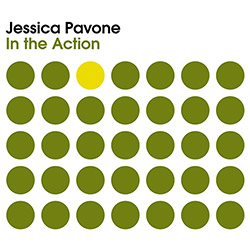
Before reading her bio or listening to an interview on Jeremiah Cymerman's 5049 podcast, I scribbled down some notes about Jessica Pavone's viola and electronic augmentation work on In the Action: "Playfully methodic, nimble, each bow bounce elicits visions of glissade and grande jeté (need to look up more ballet words), and her longer tones read as sun salutations." Now here's the thing: Due to stress, a teaching gig, and touring in cars circa 2009, Pavone developed back problems that worsened to herniated discs, the inability to lift more than ten pounds, and temporary paralysis. Surgery a few years later returned her to a new lease on music and life, and she has since entwined the importance of strengthening her body with her relationship to viola performance — both physically and creatively.
Pavone's ability to parallel expressive technique with human motion is obvious after a few reiterations/ variations on the opening motif of "Oscillatory Salt Transport": Big inhale with a single tone, slight vibrato, trill, mezzo piano to forte, exhale two elongated notes that swing back to tonic; you find yourself slow-motion rocking in anticipation of duration and pace. High register with buzzing harmonics morph into multi-string hums in duet, with any hiatus feeling monumental. Pavone's passage of repeating stabs — each note filled with unprocessed harmonic fullness — reels you in and oddly makes you long for a return to simplicity (this listener thought, "Why do I lean on so many things? Why do I have so many things? I'm going to harness my focus.") At the seven-minute mark, Pavone seems to conclude, but continues to tease the last three intervals and build an elaborate coda over the fifth (of the chord) without resolution (sorry, OCD folks).
"And Maybe in The End" grasps at the acoustic world, but is frequently tugged on by a shadowy figure. As Pavone plucks arpeggios, a growling echo fills in her pauses; moving like a sleeping juggernaut being summoned to action, each rousing creeps from gravel to dirt to barely contained feedback and back again. On a couple spots, she plunks (pizzicato) two notes through this gnarled processing, and the results resemble, say, an AM radio broadcast of a springy doorstopper struck really hard; it's a blip in the landscape of the album, and maybe not deserving of an extravagant description, but it's really cool.
Pavone shifts from first to fifth on "Look Out — Look Out — Look Out", a piece that could be mistaken for an early Einstürzende Neubauten jam. Jackhammering delay (gathered from a snippet of reverb trails?) feeds back in a rough, unrelenting ricochet removed from anything heard so far. The music evolves over six minutes through rising and falling across the frequency spectrum and eventually peeling back to a faded wobble. It's an unusual choice in the sequencing, but a great juxtaposition before the title track. On "In the Action", Pavone's major key melody and gestural approach (i.e. beginning phrases with exaggerated glissandi grace notes) border on idiosyncratic, bluegrass, hoedown fiddlin', but she bucks that label by restating the same quote, and again, and again, and again, almost sounding as a skipping record (not in a bad way — but I enjoy the sound of a skipping record). Her distorted twin returns in the form of a bubbling, bassy pulse, something she syncs with, dances around, and ignores. Ultimately, she grabs onto the grunge for an eroded, crumpling farewell.
Aside from non-musical injuries, playing an instrument takes its toll on bodies. Torn muscles, arthritis, slamming your hand under a piano lid etc. can be career-ending, as was the case with a few brass players I knew who developed embouchure dystonia (your brain and the twelve mouth muscles involved in controlling a mouthpiece do not communicate well); a brilliant (!) kid from my university had a skin graft on his cheek at age eighteen due to frequent, intense violin practice. This is all rambles to say that Pavone's rebound of physical/emotional/mental therapy is fortunate for us listeners.
Comments and Feedback:
|



